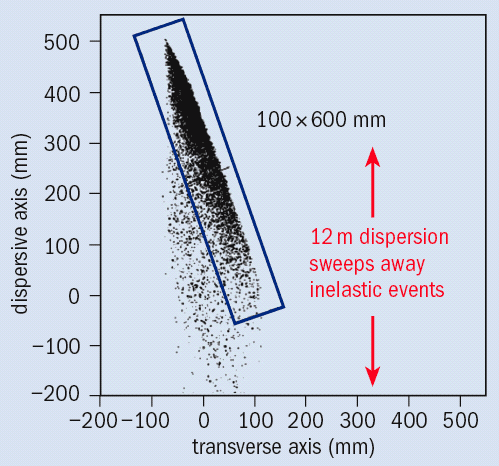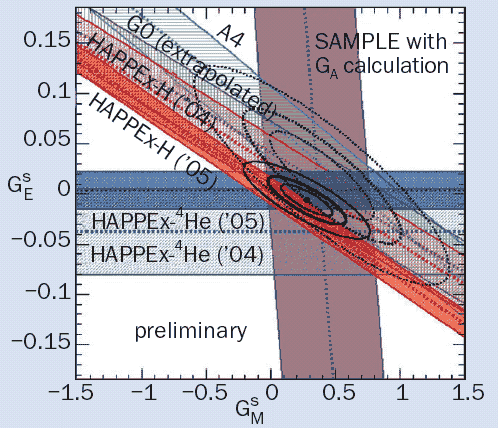Two more rounds of data taken by the Hall A Proton Parity Experiment (HAPPEx) at the US Department of Energy’s Jefferson Lab have provided the most precise constraint yet on nucleon strangeness. The result, presented at the American Physical Society April meeting in Dallas, reveals that the strange-quark contribution to the proton’s overall charge distribution and magnetic moment is small. It amounts to no more than 1% of the proton’s charge radius and no more than 4% of its magnetic moment – and in both cases, the final value could be consistent with zero.

It may seem unusual that strange quarks should be important in determining the properties of the proton as, unlike up and down quarks, they are not thought of as permanent residents of the proton. However, the strange quark may appear as part of the proton’s quark-gluon sea, the seething mass of particles that constantly blink in and out of existence due to strong force energy.

A useful method of accessing strange quarks is through parity-violating electron scattering, in which the interference of the electromagnetic force and neutral weak force is measured by scattering a beam of polarized electrons off target particles. Since the electromagnetic force is parity-symmetric, while the weak force is not, a longitudinally polarized electron beam allows experimenters to separate the electromagnetic and weak components, and by comparing their strengths they can disentangle the contributions of the up, down and strange quarks.
The HAPPEx Collaboration measured a combination of strange-quark contributions to the charge distribution and magnetization of the proton, which are represented via GsE and GsM, the strange electric and magnetic form factors, respectively. To disentangle the two form factors, the collaboration took data on two different targets: hydrogen and helium (4He). 4He has no net spin and hence no magnetic moment, and so allowed the researchers to isolate GsE.
HAPPEx took data on both targets during 2005, using a longitudinally polarized 3 GeV electron beam from Jefferson Lab’s Continuous Electron Beam Accelerator Facility. A gallium arsenide superlattice photocathode provided an average beam polarization of 86% with rapidly flipping helicity. The beam was sent into a 20-cm long cryogenic aluminum target vessel containing either hydrogen or 4He in Jefferson Lab’s Hall A. Septum magnets then deflected elastically scattered electrons, which were at a forward angle of 6°, to the Hall A High Resolution Spectrometers (HRS), located at 12.5°.
The HRS allowed a very clean separation of elastic events, with an average value of momentum-transfer squared, Q2 = 0.1 (GeV/c)2. A Cherenkov electromagnetic shower calorimeter covered the distribution of elastic events in the spectrometer focal plane. The signal was integrated over each period of constant helicity. A blinding factor was placed on the data and removed only a week before the result was presented in Dallas.
The HAPPEx results indicate small values for the strange form factorss GsM = 0.12±0.24 and GsE = -0.002±0.017. While these results are consistent with previous results from HAPPEx (Aniol et al. 2006) and world data, they reveal that the large values and possible radical Q2 dependence of the strange form factors suggested by previous data in this kinematic region, are highly unlikely. Also, while these new data are accurate enough to eliminate many models of strangeness content, they do not rule out sizable contributions at higher Q2. They are also compatible with a new analysis of world data, the result of which is in excellent agreement with modern calculations based on non-perturbative quantum chromodynamics using lattice methods and chiral extrapolation (Young et al. 2006).
Further reading
K A Aniol et al. 2006 Phys. Lett. B 635 275 and Phys. Rev. Lett. 96 022003.
R D Young et al. 2006 www.arXiv.org/abs/nucl-ex/0604010, submitted to Phys. Rev. Lett.








